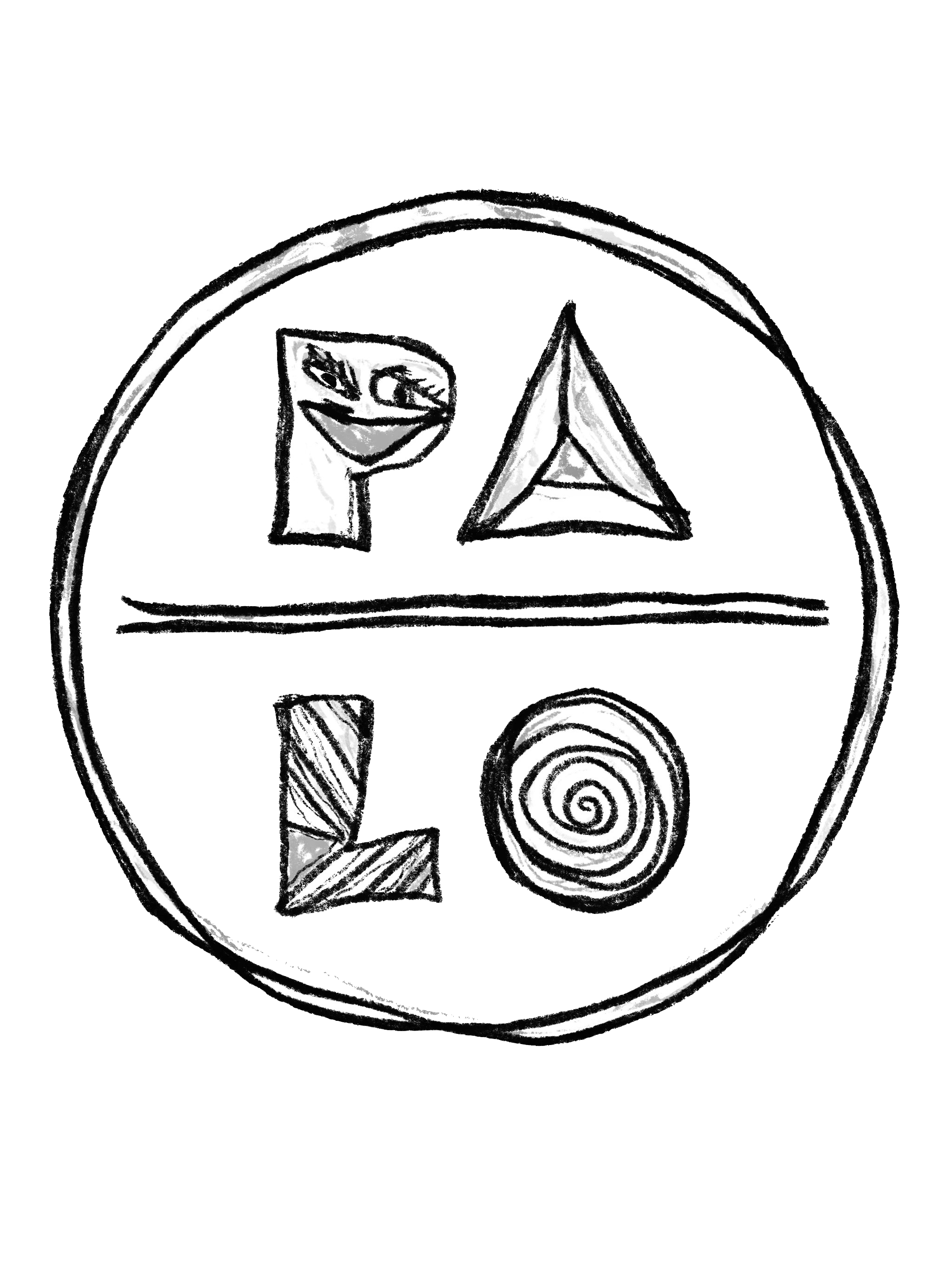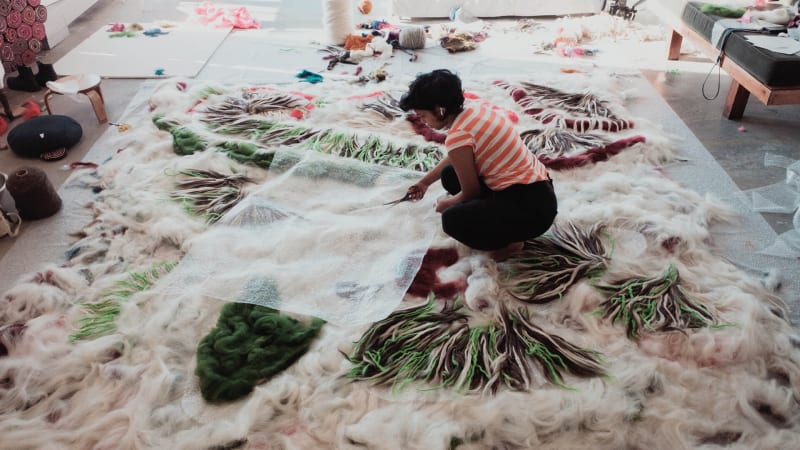Kolkata born artist Sagarika Sundaram experienced a revelation when she first learnt to create felt beads on a kitchen table in London. Rolling cylinders of wool to reveal their layered rings reminded her of a piece of jewellery she’d once seen: gold encased in rubber. “The most precious part lay inside and totally concealed to the viewer, the value of the piece lay in knowing it was there but never seeing it—unthinkable in India. It fascinated me, the tension between inside and outside, the hidden and visible,” Sundaram tells STIR. She felted a palm-sized sphere and sliced it open on the table, exposing labyrinthine layers of process and labour.
Six years later, Sundaram is making her solo debut in New York at Palo Gallery. The exhibition, titled Source, showcases her ongoing innovations in the form of hand-dyed felt: just beyond one of the split spherical works, titled Seed, massive wall reliefs and suspended sculptures emerge into view. Pieces like Trefoil and Imago take on natural motion as they twirl from the ceiling, the latter cascading red cords from its wilted centre. In the topographical map evoked by Atlas, a diagonal slash across the surface reveals a deep set underlayer of fleshy red, peeking out from beneath a stormy camouflage of kinked bolts. Book 1: 7.10.23 and Book 2: 6.9.23 make clear the modal possibility of Sundaram’s work, their felt pages ready to turn and reveal a new configuration. With burst centres, peeled-back layers, and unravelled edges, Sundaram’s surfaces resist stiffness and finality: they appear in Source as unresolved objects caught mid-metamorphosis.
From her initial endeavour to hide forms within forms, Sundaram’s practice with felt has balanced her insatiable intellectual pursuit and commitment to experimentation. “In 2023, I produced an amount of work that I look back at with surprise, because I remember at the beginning of the year feeling very open, unsure of what was coming up for me work-wise. I believe the volume of work came, in part, from seeding the idea of consistency in my practice and questioning its nature in different contexts,” she tells STIR. “I try to catch pockets of time for experimentation towards no particular end, keeping faith that the necessary connections will reveal themselves at the right time.”
Sundaram’s breakthroughs in the felt challenge and honour the history of fibre arts broadly. Earlier excluded from the realm of fine art as “women’s work,” pioneering 20thcentury artists harnessed the pliability of fabric as a medium to explore architectural forms and drive abstraction beyond painting. Sundaram carries on a legacy that spans the Pattern and Decoration Movement, Sheila Hicks, Anni Albers, among Euro-american examples, and artists such as Mrinalini Mukherjee and Sheela Gowda in India. At the same time, Sundaram’s artistic vocabulary also draws from the predominance of textile arts in South Asia as she references an early literacy in folding and pleating cloth, and vivid memories of her grandmother meticulously washing her nine-yard sari in her Chennai(Madras) apartment.
The discovery of fabric as an art form, and her intrepid impulse to push it beyond traditional bounds, began for Sundaram at Rishi Valley School (Andhra Pradesh), the experimental boarding school in southern India that was pivotal for her early creative development. There, she had the opportunity to practise Indonesian Batik textile painting through the 12th grade. Subsequently, Sundaram carried with her the instinct to deconstruct rules in her undergraduate study of graphic design. “I looked at the course of study as a kind of framework for any kind of creative work. I see the intricacies of publication design—typesetting, weight of paper, colour separation, type of printing—as a set of domain-specific parameters that I need to be familiar with, in the way that I need to know another set of parameters to weave or dye textiles. When I studied textiles informally in London, I was constantly making connections back to my training as a graphic designer,” she tells STIR. “The most valuable lesson I learned from one weaving teacher was to not be intimidated by technique. I like to remember that most textile arts were never practised in the university setting but were brought there later. Taking this approach helps me lower the stakes and find freedom in the work.”
Approaching her practice as an ongoing research project, Sundaram’s recent work inquires into concerns of origin and history. Among the most ancient of textile mediums, she sees felt as an elementary unit of human civilisation, patterned alongside the development of agriculture, architecture, and cloth-making. “Across Central Asia, the Silk Road, in China, Tukey, Iran, India, Iraq—the Fertile Crescent, the birthplace of civilisation—wherever there are sheep, there’s felt. I describe it like a connective tissue,” she remarked in an interview with Andrew Gardner, published by Palo Gallery in the catalogue for Source. Working with the medium in the 21st century, she pays attention to the origins of her wools and dyes in an ever-growing network of suppliers, which range from the Himalayas to the Hudson Valley. Sundaram carefully considers gradations of textures that vary with each new source, observing that a sheep’s habitat has an indelible impact on both the felting process and its result.
Part of the artist’s investigation into the material journey of felt also lies in its capability for transformation. After laying the wool down on the floor, Sundaram composes a piece in reverse, starting on the outer surface before building the body. In the process, the fabric offers itself to different treatments—slicing, coiling, folding—enacted intuitively by the artist. “I am able to think ‘in’ the medium, ask questions, shape it in all these ways that are expressive and allow for the creation of a wide artistic vocabulary. Using a process that is as old as history itself, I find myself able to build entire worlds that are a thrill to dive down,” she says.
Hybrids of memory and destiny, the works featured in Source expose their interior layers to signal their journey from source to the present moment. Circular and nested forms appear frequently, an aesthetic gesture to the central point of a piece’s beginning. Repeated openings in their surface mimic inquiry into their latent heritage, indicative of the fervent research that characterises Sundaram’s unique approach to making. Recalling her inspiration for the first split sphere she made in London, Sundaram follows the genesis of her felting technique into her vision for future work. “All the works in the Palo show, made almost six years later, are an extension of this line of inquiry, related to hiding a form within a form. I am experiencing the question as a very generative place to be, and I plan to be here until the questions stop coming,” she tells STIR.


